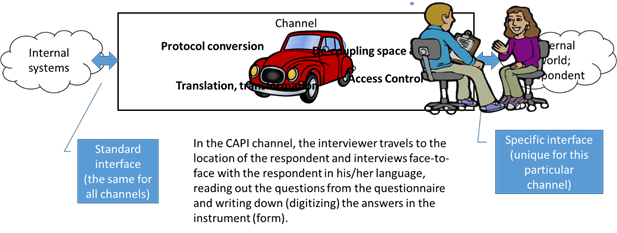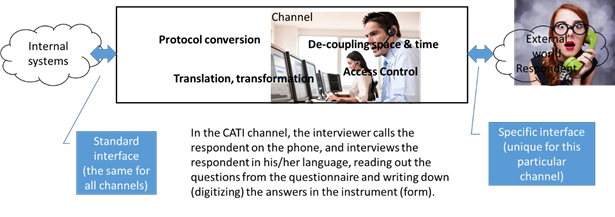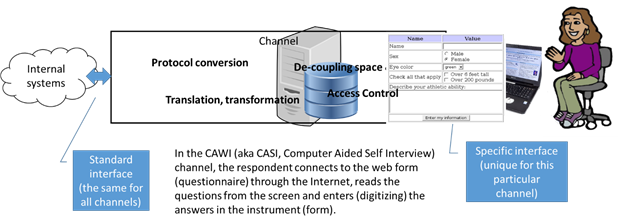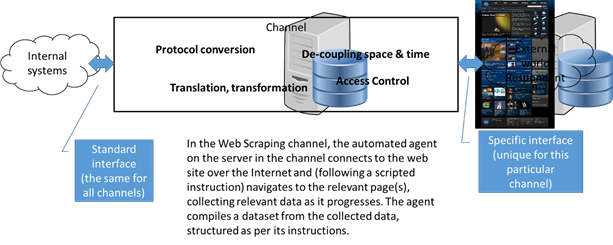Login required to access some wiki spaces. Please register to create your login credentials
|
198. In many organizations, channels are implemented as generic capabilities, like CATI, CAPI or CAWI, that can be configured or organized to execute specific surveys. Statistical organizations are known to organize themselves in such a way that Data Collection is a separate organizational unit, of which the channels are a part. Often, they provide a business service to other parts of the organization.
199. Exchange channels deliver data (datasets) and metadata, mostly process meta and para-data. Exchange channels are configured through metadata (designs), often embedded in instruments, tools and questionnaires.
200. The following examples will clarify some of this. For clarity, we’ll start with some examples that should be familiar, examples taken from traditional Data Collection.
A. Example 1: The CAPI (person-to-person interviewing) channel.
Figure 19; CAPI channel
201. In this example, the interface presented on the outside, is the oral and body language interaction between interviewer and respondent. The interviewer may have to translate the questions and/or the answers, but as a minimum, he will have to digitize the answers, using some means (such as a laptop computer) that is also part of the channel, just as the interviewer himself is part of the channel.
B. Example 2: The CATI (telephone interviewing) channel.
Figure 20: CATI channel
202. The CATI channel presents a different interface on the outside, namely the sound waves the are transmitted from/to the telephone. Note, that in this case the channel uses equipment (the telephone network and the respondent’s extension) that is not owned by the statistical organisation. Again, the interviewer will have the task to translate (digitize) the spoken word into digital information.
C. Example 3: The CAWI (web form self-interviewing) channel.
Figure 21: CAWI channel
203. In this example, again the channel uses equipment that is not owned by the statistical organisation: the internet and the respondent’s computer. The interface presented to the respondent (the information provider) is the image (the questionnaire) on his/her computer, and the mouse and keyboard for entering the answers. The act of digitizing is “outsourced” to the respondent.
D. Example 4: A web scraping channel
Figure 22: Web scraping channel
204. In web scraping, the channel uses the Internet to connect to some relevant web site and uses an internal script to navigate that web site and collect from it the relevant information. The script, executed by some automated agent, is the equivalent of the human interviewer, the external web site is the representation of the data provider (the respondent). Again, the channel uses some technology (such as the Internet) that is not owned by the statistical organisation.
E. Example 5: connecting to a public administrative data source
205. This example is very similar to the previous one in terms of technology used. The relevant difference is, that the provider is not just providing information about a single entity (unit), but about a large collection of units, such as a whole population. And of course, there may be technological differences, too, such as directly connecting to a database or using some web service provided by the data provider.



